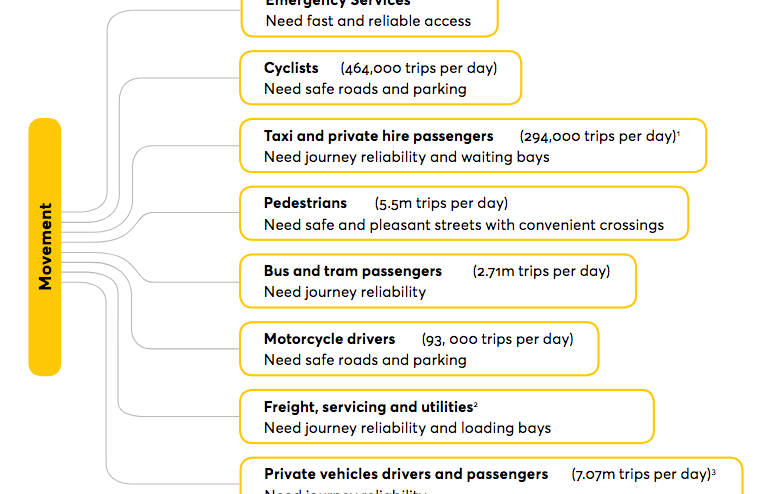I was a member of a Commission on the future of London’s roads and streets convened by the Centre for London. Our report was launched yesterday.
This was a worthwhile exercise that stimulated thought and discussion amongst the expert members. The report will contribute to the actions that will be needed to implement the plans of the Mayor’s Transport Strategy. Some of the toughest issues concern the management of demand for both road space and kerb space while maintaining traffic flow and improving the quality of place in a city growing at the rate of about 100,000 people a year.
Travel time and congestion
Britain’s National Travel Survey has been monitoring our travel patterns for the past 40 years. One remarkable finding is that average travel time has held steady over this period at about 375 hours per person per year, close to an hour a day. There are only 24 hours in the day and many activities that have to be fitted in, leaving an hour or so for daily travel. The history of travel is largely about travelling faster as incomes have grown and technologies advanced, allowing us to go further in the same amount of time.
This travel time constraint is an important influence on road traffic congestion. As traffic builds up, speeds fall and trips take longer. This puts pressure on time available for travel and some road users change their plans – travelling at a less busy time, or to a different destination (where options exist, as for shopping), or by a different mode, or not to travel at all. So congestion is self-regulating, and gridlock is rare, particularly when an urban traffic management system is used to adjust the timing of traffic signals to make best use of road space, as in London.
Road traffic congestion occurs in areas of high population density and high car ownership. There is insufficient road capacity to accommodate all the trips that might be made. Many potential road users are deterred by the prospect of time delays. These suppressed trips mean that congestion is difficult to mitigate since measures aimed at reducing car use in effect create space for drivers previously deterred.
Policies that it is hoped would reduce congestion by getting people out of their cars tend to disappoint. Promoting walking and cycling is good for health and for the environment but has little impact of urban car use. Increasing road capacity induces more traffic, hence the maxim that you can’t build your way out of congestion, which we know from experience to be generally true.
Congestion charging
London pioneered congestion charging, aimed at reducing demand for car use in the central area. On introduction in 2003 there was a marked impact – both car use and delays were reduced. But when the charge was increased from £5 to £8 in 2005, there was no further effect, and over the next few years delays reverted to the previous level. So while congestion charging has generated useful amounts of revenue for investment in London’s transport system, it has been disappointing as a means of reducing congestion – because of the high potential demand from drivers willing to pay the current charge of £11.50. It seems likely that a substantially higher charge would be needed to make a significant impact on congestion in a city like London where many have high incomes.
When road users are asked why congestion is a problem, their main concern is the uncertainty of journey time. While it is difficult to reduce general delays arising from congestion, new technologies are able to lessen uncertainty. The route planning offered by smartphone apps such as Google Maps and Waze, and similar in-vehicle devices, takes account of traffic congestion in real time and proposes less congested routes, making better use of the road network. These apps also estimate journey time, which helps decide the best time to start a trip.
Performance of the route guidance apps would be enhanced by collaboration with road authorities. Transport for London’s 2017 Business Plan announced a new partnership with Google on its Waze technology that will see Google use TfL’s open data, while TfL uses the Waze crowd-sourced data on road conditions to help manage traffic around incidents and road closures.
These new technologies are helping us make better use of the road system within the limited time we can allow ourselves for daily travel.

